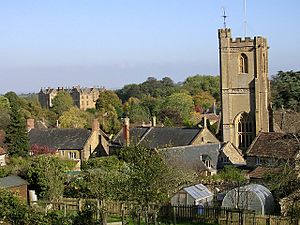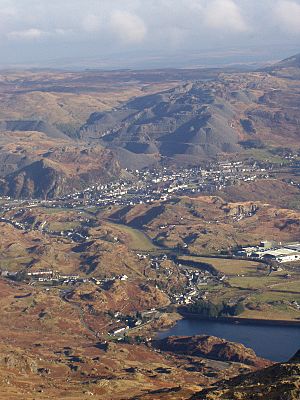John Cowper Powys facts for kids
Quick facts for kids
John Cowper Powys
|
|
|---|---|
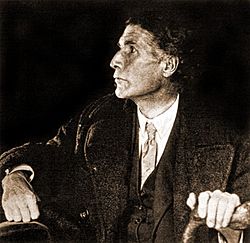 |
|
| Born | John Cowper Powys 8 October 1872 Shirley, Derbyshire, England |
| Died | 17 June 1963 (aged 90) Blaenau Ffestiniog, Wales |
| Occupation | Philosopher, poet, lecturer, novelist, literary critic |
| Alma mater | Corpus Christi College, Cambridge University |
| Period | 1915–1963 |
| Genre | Novel, poetry, philosophy |
| Notable works | Wolf Solent (1929) A Glastonbury Romance (1932) Autobiography (1934) Owen Glendower (1941) Porius (1951) |
| Spouses | Margaret Lyon Phyllis Playter |
John Cowper Powys (8 October 1872 – 17 June 1963) was an English writer. He was a philosopher, lecturer, novelist, critic, and poet. He was born in Shirley, Derbyshire, England. His father was a vicar there.
Powys started publishing poetry in 1896 and his first novel in 1915. However, he became truly successful with his novel Wolf Solent in 1929. Many people saw him as a writer similar to Thomas Hardy. His novels often featured important landscapes, much like Hardy's stories.
In 1934, Powys published his Autobiography. He was also a very popular lecturer in England and the United States. He lived in the US from 1905 to 1930. Many of his novels were written and first published there.
In 1934, he moved to Dorset, England, with his partner, Phyllis Playter. A year later, they moved to Corwen, Merionethshire, Wales. He wrote two novels set in Wales. In 1955, they moved to Blaenau Ffestiniog, where he died in 1963.
Contents
Biography
Early life
John Cowper Powys was born in Shirley, Derbyshire, in 1872. His father was Reverend Charles Francis Powys. His mother was Mary Cowper Johnson. She was related to the poet William Cowper.
John was one of eleven children. Many of his brothers and sisters were also very talented. His family lived in Shirley, then briefly in Dorchester, Dorset. After that, they moved to Montacute, Somerset. His father was a vicar there for 32 years.
John's two younger brothers, Llewelyn Powys and Theodore Francis Powys, became famous writers. His sister Philippa Powys published a novel and some poetry. Another sister, Marian Powys, was an expert on lace. His brother Albert Powys wrote books about architecture.
Powys went to Sherborne School. He then studied at Corpus Christi College, Cambridge, and graduated in 1894. In 1896, he married Margaret Lyon. They had a son named Littleton Alfred in 1902. Powys first worked as a teacher in girls' schools. Later, he became a lecturer for Oxford and Cambridge Universities.
Lecturer in America
From 1905 to the early 1930s, Powys lectured in the United States. He worked for the American Society for the Extension of University Teaching. He became known as a very exciting speaker. He traveled all over the US and Canada during this time.
Powys met Phyllis Playter in 1921. She was 26 years old. They began a long-term relationship. He could not divorce his wife, Margaret, but he always supported her and their son's education.
In the US, Powys had public debates with famous philosophers. These included Bertrand Russell and Will Durant. He also supported the Spanish Revolution of 1936.
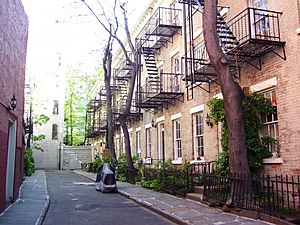
His first novel, Wood and Stone, was published in 1915. He dedicated it to Thomas Hardy. He also published collections of essays. In 1916, he wrote Confessions of Two Brothers, which shared his personal philosophy. He also published three poetry collections.
Powys described himself as an anarchist. This means he believed in a society without government. He was against both fascism and Stalinism. These were two types of strict, controlling governments.
In 1929, Powys finally found success with his novel Wolf Solent. In 1930, he and Phyllis moved from Greenwich Village in New York City to a rural area in upstate New York. His novel A Glastonbury Romance, published in 1932, sold very well. However, he made little money from it due to a lawsuit. His important book, Autobiography, came out in 1934.
Settling in Wales
In June 1934, Powys and Phyllis left America and moved back to England. They first lived in Dorchester, Dorset. This town was the setting for his last "Wessex" novel, Maiden Castle.
In July 1935, they moved to Corwen, Denbighshire, in North Wales. A novelist named James Hanley helped them. Corwen was a very old part of Wales. There, Powys learned about Welsh literature, myths, and culture. He even learned to read Welsh.
This move inspired two major historical novels set in Wales. These were Owen Glendower (1941) and Porius (1951).
Margaret Powys, his wife, died in 1947. His son, Littleton Alfred, died in 1954. In May 1955, John Cowper Powys and Phyllis moved for the last time. They went to Blaenau Ffestiniog in North Wales. John Cowper Powys died there in 1963. Phyllis Playter died in 1982.
Works
Poetry
Powys's first published works were poetry collections. These included Odes and Other Poems (1896) and Poems (1899). These poems showed influences from famous poets like Alfred, Lord Tennyson and William Wordsworth.
In 1905, Powys wrote a long poem called "The Death of God." It was published as Lucifer in 1956. He also published three more poetry books: Wolf's Bane (1916), Mandragora (1917), and Samphire (1922).
Novels
Wessex novels
Powys was a famous lecturer and published many books. But he only became a successful novelist in his early fifties. This was after his novel Wolf Solent was published in 1929. This book was printed many times and translated into other languages.
Powys wrote that Wolf Solent was about "Nostalgia." This means a longing for home. He wrote it while he was in a foreign country. The story is set in places like Sherborne and Dorchester in Dorset. These places held many memories for him.
Before Wolf Solent, he had written four earlier novels. These included Wood and Stone (1915) and Ducdame (1925). Wolf Solent was the first of his "Wessex novels." These also included A Glastonbury Romance (1932), Weymouth Sands (1934), and Maiden Castle (1936).
Powys admired Thomas Hardy. His Wessex novels are set in Somerset and Dorset, which are parts of Hardy's fictional "Wessex." These four novels were very popular with readers at the time. Maiden Castle is set in Dorchester, Dorset, which was also the setting for Hardy's The Mayor of Casterbridge. Powys wanted his novel to be a rival to Hardy's.
Powys was influenced by many writers. These included Fyodor Dostoevsky, Marcel Proust, and James Joyce. His success was also helped by his relationship with Phyllis Playter. She often gave him advice on his writing.
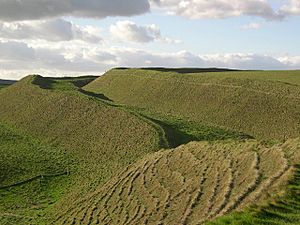
A Glastonbury Romance sold very well in Britain. However, it led to an expensive lawsuit. The owner of the Wookey Hole Caves felt he was unfairly shown in the book.
The main character of A Glastonbury Romance is the Grail. The book explores the myths and history of Glastonbury. It includes the legend that Joseph of Arimathea brought the Grail there. It also mentions the tradition that King Arthur was buried there. One character in the novel suggests the Grail has an older, non-Christian origin.
A key part of the novel is John Geard's attempt to make Glastonbury a religious pilgrimage site again. He was the Mayor of Glastonbury. Other characters, like Philip Crow, dislike the town's myths. Philip wants more mines and factories.
Welsh novels
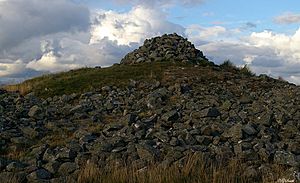
Welsh mythology became even more important in Powys's novels after he moved to Corwen, Wales, in 1935. This was first seen in Morwyn or The Vengeance of God (1937). This novel also strongly spoke out against animal cruelty. Powys believed that vivisection, which is experimenting on live animals, was a terrible crime. He supported the movement to stop it.
After that, he wrote two major historical novels set in Wales. These were Owen Glendower (1941) and Porius (1951). Owen Glendower is about the rebellion of the Welsh Prince Owain Glyndŵr in the 1400s. Porius takes place in the time of the legendary King Arthur around 499 CE.
In both books, especially Porius, Powys used myths from the Welsh classic The Mabinogion. Many people consider Porius to be one of Powys's greatest achievements.
It made sense for Powys to write about Owain Glyndŵr after moving to Corwen. Glyndŵr's rebellion against Henry IV of England began in Corwen in 1400. Powys started writing Owen Glendower when the Spanish Civil War was happening. He finished it a few months after World War II began. The novel shows how historical events can feel similar to current times.
Porius is mostly set in Corwen. The story happens in one week in October 499 CE. This was a time when Roman traditions were being replaced by Saxon rule in Britain. It was also when Christianity was spreading. Powys saw parallels between this time and the 1930s and 1940s. He felt both were times of "appalling transition." He started writing Porius in 1942, when another "Saxon" invasion seemed possible during World War II.
Powys believed that Glyndŵr's rebellion also happened during a time of great change. Just as the landscapes of Dorset and Somerset were important in his Wessex novels, the landscape of Wales became very significant in his later works. This was especially true for the Corwen region.
The natural world, including the sky, wind, plants, and animals, is very important in all of Powys's books. He was influenced by Romanticism, especially writers like William Wordsworth. Powys believed that adults could keep the joyful connection to nature that children have. He thought this could be done by using imagination. Some people compare his ideas to Zen practices. For Powys, connecting with nature was as important as religion was for earlier generations.
Late novels
The novels Powys wrote after Porius are shorter and have fantasy elements. The Inmates (1952) is set in a mental hospital. It shows Powys's interest in mental illness. Atlantis (1954) is set in the world of Homer. The main character is Nisos, the son of Odysseus. He plans to sail west over the sunken Atlantis. Powys's last stories, like Up and Out (1957), use ideas from science fiction.
Non-fiction
Autobiographical
One of Powys's most important books is his Autobiography (1934). It describes the first 60 years of his life. He tried to be very honest about himself. However, he did not discuss the women in his life in detail. This was because he was still married to Margaret but living with Phyllis Playter.
The writer J. B. Priestley said that this book alone showed Powys was a "writer of genius." It has been compared to Confessions of Jean-Jacques Rousseau.
John Cowper Powys wrote many letters. Many of them have been published. He also kept a diary from 1929, and parts of it have been published. He wrote to other novelists like Theodore Dreiser and Henry Miller. He also replied to many ordinary readers who wrote to him.
Philosophy
For almost 50 years, Powys wrote books about his personal philosophy of life. These were not academic philosophy books. They were more like "self-help" books. Powys described A Philosophy of Solitude (1933) as a "short textbook." It was about "mental tricks" to find happiness in life.
These philosophy books were often bestsellers, especially in the United States. The Meaning of Culture (1929) was printed 20 times during Powys's life. In Defence of Sensuality and A Philosophy of Solitude were also very popular.
Literary criticism
Powys used his fame as a lecturer to publish literary essays. Visions and Revisions (1915) was one of these collections. It was very popular. Over the next 30 years, he published more essay collections. He also wrote studies on writers like Dorothy Richardson, Fyodor Dostoevsky, and François Rabelais. He wrote essays on Marcel Proust and James Joyce.
Reviewers generally liked Powys's literary criticism. One writer, Kenneth Hopkins, said that The Pleasures of Literature was a great book for general readers. His book on Rabelais was especially praised. A French translation of his Rabelais book was published in 1990.
Recognition
In 1958, Powys received an award from the Hamburg Free Academy of Arts. This was for his great contributions to literature and philosophy. On July 23, 1962, when he was 90 years old, he received an honorary degree. This was from the University of Wales at University College, Swansea. He was called the "patriarch of the literature of these islands."
He was also nominated for the Nobel Prize in Literature three times. His works have been translated into French, German, Swedish, Japanese, and other languages.
See also
 In Spanish: John Cowper Powys para niños
In Spanish: John Cowper Powys para niños


